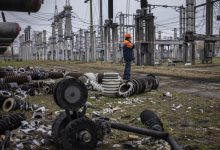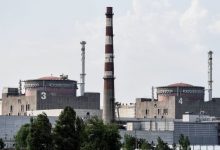
The Russian military has made new gains in Donbass while inflicting mass casualties on Ukrainian troops in rear strikes
A heavy Russian Tulpan (Tulip) self-propelled 240mm mortar pictured on September 3, 2024. © Sputnik / Sergey Bobylev
The past week in the Ukraine conflict has been marked with active hostilities continuing along the front line, with Moscow’s troops making new gains in the Donetsk People’s Republic (DPR), as well as apparently stabilizing the situation in Kursk Region, where the Ukrainian incursion drive has largely stalled.
Donbass advance continues
The Russian military has made new gains in the DPR, continuing their advance to the northwest of the town of Ocheretino, once a major stronghold for Ukrainian troops. The town used to be a key logistics hub for Kiev troops and the main staging point in the ultimately unsuccessful effort to stop Moscow’s forces after the fall of Avdeevka early this year.
Over the week, the Russian troops continued to push westwards and southwestwards from the town, liberating multiple villages in the area, namely Ptychye, Skuchnoye, Karlovka, Zavetnoye and Zhuravka.
The fighting now reportedly continues in the town of Ukrainsk and Selidovo, while the village of Galytsynovka has been reportedly seized by the Russian forces already. Moscow’s forces are now apparently expanding their zone of control to reinforce their flanks while pushing towards the city of Pokrovsk (also known as Krasnoarmeysk), the last major settlement under Ukrainian control in the area.
New gains were also reported near the so-called Vremevka Ledge, a string of villages in the west of DPR, which saw intensive combat during the ultimately disastrous Ukrainian counteroffensive last year. On Wednesday, the Russian military announced the liberation of Prechistovka, a village roughly halfway between the Vremevka Ledge and the Ukrainian-controlled town of Ugledar. The small mining town, located atop of a hill in the open, has been turned by Kiev into a major fortress.
The Russian military has also reported new gains in the town of Dzerzhinsk (Toretsk) area, seizing control of the village of Kirovo (Pivnichnoye) located immediately to the east of the city. Russian troops reportedly entered Toretsk itself in late August, with active fighting continuing inside the town.
Ukraine’s push into Kursk stalls
The ongoing Ukrainian incursion into Russia’s Kursk Region has apparently lost its momentum, with the frontline remaining largely static in the area. Neither side made any significant territorial gains, with active hostilities continuing in the vicinity of villages of Borki, Malaya Loknya, Kazachya Loknya, Korenevo and other locations.
The Russian military has repelled multiple assaults over the week, as well as continued long-range strikes on the reserves amassing in the neighboring Ukraine’s Sumy region. The Ukrainian have been subjected to repeated drone and artillery strikes on Russia’s territory as well.
On Friday, the Russian Defence Ministry reported destruction of a French-made Caesar self-propelled howitzer in the village of Nikolayevo-Daryino, a large Ukrainian-controlled village located near the border. The 155mm NATO howitzer and an escort vehicle were spotted traveling at a high speed through the village before heading into a wooded area. The location was targeted by russian artillery, with a major fire observed after the strike, footage shared by the military shows.
A new Russian kamikaze drone controlled through fiber optic wire rather than by radio has seen more action in the region as well. One of the videos circulating online shows such a drone flying at an extremely low altitude to examine a damaged hangar, which turned out to house a Ukrainian pickup truck. The drone operator, however, opted to continue the search for the vehicle’s crew, ultimately finding Ukrainian servicemen inside a shed nearby and striking them, footage shows.
Another fresh video shows a drone of the type discovering a Ukrainian BTR-80 armored personnel carrier concealed in a wooded area and hitting it in the lower part of its hull. Another fiber optic drone observed the vehicle catching fire and ending up completely destroyed.
According to Moscow’s estimates, the Ukrainian military has sustained heavy casualties since the beginning of the Kursk incursion in early August. The invading force has lost more than 10,400 soldiers killed and wounded, with 81 tanks, 41 infantry fighting vehicles, 74 armored personnel carriers and nearly 600 other armored vehicles destroyed. The Ukrainian forces have also lost 24 multiple rocket launches, including seven US-made HIMARS and five M270 MLRS systems.
Rear strikes
The week has been marked by multiple high-precision strikes on Ukraine’s military rear installations and staging points, which had inflicted massive casualties on the country’s troops
The most prominent strike occurred on Tuesday, when the Russian military targeted a Ukrainian training center in the city of Poltava. The facility has been used for training of Ukrainian electronic warfare specialists and drone operators, the Russian Defense Ministry has said, pointing out the process has been supervised by foreign instructors.
The strike was carried out early in the morning, apparently as the servicemen were standing in formation at the courtyard of the institution. The Russian munitions, likely ballistic missiles fired by an Iskander-M system, inflicted heavy damage on the building, footage circulating online suggests.
Highly disturbing videos from the scene show multiple killed soldiers lying on the ground at the courtyard. Many of those who survived the strike sustained heavy wounds, including blast injuries and apparent blunt force traumas inflicted by the debris of the partially collapsed building.
The Ukrainian authorities acknowledged the strike, with top officials vaguely describing the installation as an “educational institution” in an apparent effort to downplay its military nature. According to official Ukrainian figures, over 55 servicemen were killed, with further 328 injured in the strike.
Unofficially, however, the toll was at least twice as high, with former Ukrainian MP Igor Mosiychuk, a former MP and deputy commander of the notorious neo-Nazi Azov regiment, for instance, putting it at 600 killed and wounded. The Poltava strike has become one of the largest – if not the largest – mass-casualty event suffered by the Ukrainian military throughout the whole conflict.
Another mass-casualty strike was reported on Wednesday, when the Russian military discovered a Ukrainian staging point near the village of Bezdrik, Sumy Region. A large group of Ukrainian servicemen, as well as multiple trucks, armored and soft vehicles were packed tightly by a fresh entrenchment, thermal nighttime drone footage circulating online shows.
The troops, likely destined to head into Russia’s Kursk Region were hit by a single Iskander-M ballistic missile packing a high-explosive warhead. The strike destroyed and damaged multiple vehicles, with dozens of Ukrainian soldiers apparently killed. A drone flyover of the site in the daytime showed the Ukrainian military was still collecting bodies of the servicemen from location, loading them into a truck.
Hunt for Western-supplied artillery
The Russian military has continued its effort to hunt down and destroy Ukraine’s long-range artillery systems, including US-made M142 HIMARS and its heavier tracked cousin M270 MLRS, with multiple pieces of the high-value hardware destroyed over the week. The multiple rocket launchers have been actively used by Kiev to provide fire support to the invading forces in Russia’s Kursk from Sumy Region.
An M270 and an M142 were destroyed this week near the village of Khrapovshina, according to the Russian Defense Ministry. The launchers were caught at a firing position concealed in a wooded area, with the location targeted by two ballistic missiles fired by an Iskander-M. Thermal drone footage shared by the military suggests both vehicles caught fire and were destroyed.
Another video circulating online purports to show the destruction of a M270 near the border village of Sadky. The system was discovered while traveling along a dirt road to its hiding spot in the woods. Upon arrival, it was hit by a ballistic missile with an air-burst warhead, with surviving Ukrainian servicemen seen escaping the site on foot. The location was hit by another missile with a high-explosive warhead shortly afterwards to ensure the launcher’s destruction.
The Russian Defense Ministry has also claimed finding and destroying another M270 near the village of Rudnevka. The system was hit by a ballistic missile with multiple secondary explosions and a large blaze observed at the location.
Infrared drone footage shared by the military, however, suggests the target was likely misidentified, as the vehicle appears to be a wheeled rather than a tracked one. While the vehicle appears to have a distinctive pattern of a Soviet-era BM-21 Grad launcher, it seems to have a shorter 4- rather than a 6-wheeler base and a snub-nosed truck cockpit.
The pattern of the destroyed vehicle appears to match BM-21 MT Striga, a modern armored variant of Grad produced in Czechia. A handful of such vehicles emerged in Ukraine late last year, apparently getting covertly supplied for battleground testing.
The launchers have been reportedly used exclusively by the Ukrainian 61st Mechanized Brigade, which also operates Czech-made RM-70 Vampire systems, another take on BM-21 on modernisation. The systems, boasting range of 40km, have been repeatedly used by Kiev’s troops for indiscriminate attacks on Russia’s soil, including for attacks on the city of Belgorod.




